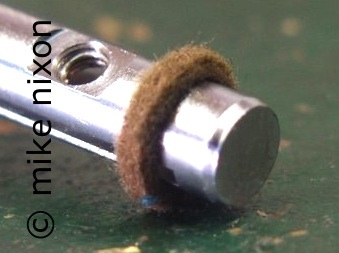  ® ®
|
Carburetor felt seals |
|
Many Keihin carbs have seals that are so loose you would intuit they would have to affect performance. But guess what: they don't. The fact is, the felt seals on carburetor throttle and choke shafts are not perfect seals and are not designed to be. Think about it: can felt really seal? They are dust seals. Replacing them will not solve a performance issue.
A related misunderstanding is the idea that spraying flammable aerosol products onto or around carburetors can help detect vacuum leaks. This fallacy virtually defines motorcycle user forums. But no thinking mechanic uses anything like that method to check for vacuum leaks. A carburetor has half a dozen openings to atmosphere all around it. Any flammable substance sprayed even a short distance -- let alone right at -- the carburetor is going to be picked up by the carburetor and will then affect engine running. Doesn't tell you anything. A professional mechanic uses the historic less air/more tests to find vacuum leaks, not sprayed chemicals.
A third tie-in to the subject of throttle shaft seals is the mistaken belief that chemical dip and other immersion methods of carburetor cleaning necessarily hurt the seals. Sure, felt type seals deteriorate over time and become dried up and shrunken, in extreme cases to the point that removing them results in their basically flaking away into dusty bits on the workbench. But that's not the fault of dipping. That's entropy. Again, they're only dust seals, long-term guardians of the throttle shaft bearings.
Instead of all this hand-wringing over supposed effects throttle shaft seals have on performance, it is much wiser to go after the things that really do hurt engine efficiency. There are several. The number one thing to eliminate as a performance problem on vintage Japanese bikes is low cylinder compression. See my articles on this. The fact is, the years do one big thing to Honda engines: makes 'em "out of breath". I tell all my customers they want 150 psi ("book" for many vintage Honda engines is 170), but unfortunately 120~140 is very common. It makes little sense to spend your energy on anything else--ignition, carburetors, whatever--if your engine develops less than 150 psi.
|
|
Written March 2022. Last updated January 2025 Email me © 1997-2025 Mike Nixon |
 Many believe that engine performance issues can frequently be traced to vacuum leaks at the throttle shafts. Sounds logical. Too bad it just isn't so. In more than 50 years rebuilding carburetors, I have yet to encounter this. In each case it was found that there was another, completely different issue. Whether bowl venting problems, incomplete cleaning, inadvisable use of aftermarket parts, ignition timing issues, or simply inexpert carburetor adjustment, these shortcomings are often the problem.
Many believe that engine performance issues can frequently be traced to vacuum leaks at the throttle shafts. Sounds logical. Too bad it just isn't so. In more than 50 years rebuilding carburetors, I have yet to encounter this. In each case it was found that there was another, completely different issue. Whether bowl venting problems, incomplete cleaning, inadvisable use of aftermarket parts, ignition timing issues, or simply inexpert carburetor adjustment, these shortcomings are often the problem.